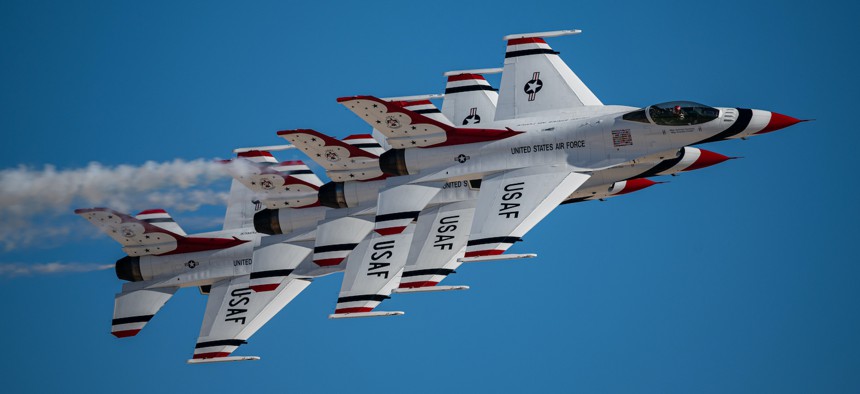
F-16 Fighting Falcon fighter jets assigned to the U.S. Air Force Air Demonstration Squadron “Thunderbirds” perform an aerial demonstration during the Aviation Nation 2022 airshow at Nellis Air Force Base, Nevada, Nov. 4, 2022. U.S. Air Force / Airman 1st Class Josey Blades
The Air & Space Brief: Tanker damage; Pacific comms; Smaller sats, at last; and more
Welcome to the Defense One Air and Space newsletter. Here are our top stories this week:
C-130H damage. The Air Force’s procedure of etching serial numbers on propellers “likely contributed to cracks that are being found on the C-130Hs,” about 100 of which have been grounded since early October, an Air Force spokesperson told Defense One’s Marcus Weisgerber. Read more of the exclusive story, here.
Comm check. Air Force intelligence must be able to operate whether they have full connectivity or no connectivity at all, so the Air Force Research Laboratory is building in “as much redundancy as possible” as it plans for the future, Defense One’s Lauren C. Williams reports. “The public cloud offers great services as long as you have connectivity. If you’re disconnected, how do you still function and do what you need to do during that time frame?” said Norman Leach, a director in the lab’s information directorate. “You need to be able to get stuff through with those higher latencies and lower network comms.”
Smaller satellites. The Space Force’s long-anticipated move to cheaper, smaller satellites is the official policy as of Oct. 31, Defense One’s Marcus Weisgerber reports. Acquisition chief Frank Calvelli made the decision shortly after the Space Development Agency, which buys satellites, was formally transferred from the Office of the Secretary of Defense to the Space Force.
Defending Taiwan. If China tries to seize Taiwan in “the next year or two,” U.S. Indo-Pacific Command would not be ready to defend it, and the resulting assembly of forces would be akin to a “pick-up squad” facing “a well-prepared team,” Hudson Institute senior fellow Bryan Clark writes for Defense One. To avoid that scenario, the Pentagon should establish Joint Task Forces, he writes, to “fill a gap left by the Goldwater-Nichols Act of 1986.”
Sign up to get The Air & Space Brief every Tuesday from Jennifer Hlad, Defense One’s news editor. On this day in 1950, U.S. Air Force Lt. Russell J. Brown shot down two North Korean MiG-15s with his F-80 Shooting Star. It was the first all-jet air combat battle, and it lasted about 30 seconds.
 From Defense One
From Defense One
More Than 100 C-130s Are Down, Likely Because Mechanics Scratched Their Propellers, Air Force Says // Marcus Weisgerber
The standard practice of inscribing serial numbers during inspections turns out to be counterproductive.
Meet the Man Trying to Change the Culture of Boeing Defense // Marcus Weisgerber
CEO Ted Colbert says reducing groupthink is part of the path to a nimbler, networked weapons company.
Military Leaders Praise Musk as Treasury Officials Eye Twitter Deal // Jennifer Hlad
Outgoing Chief of Space Operations Gen. Jay Raymond thanked the SpaceX CEO "for being here."




